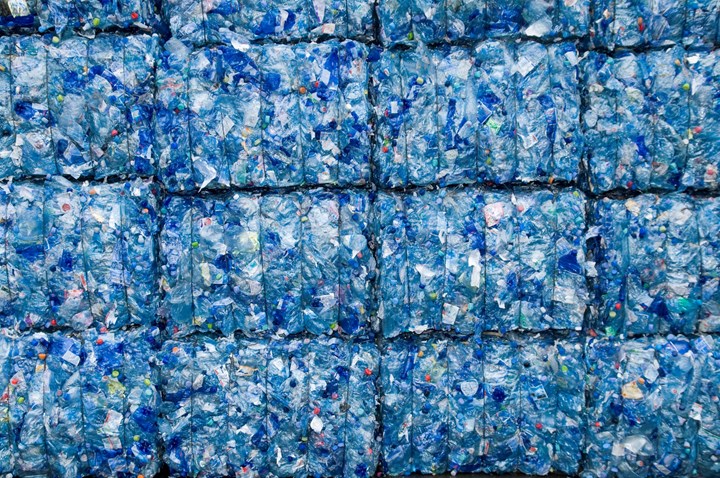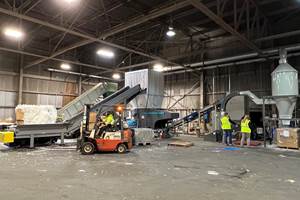What Type of Recycling Technology Works the Best? It Depends
NREL scientists describe a framework for comparing recycling technologies.
An article published January 12th in the ACS journal Sustainable Chemistry & Engineering quantifies and compares the merits of recycling technologies for major commercially produced polymers. The strategy, developed by a team at the National Renewable Energy Laboratory, illuminates differences in the technical performance of produced material as well as environmental and economic impacts.
The recycling of HDPE, LDPE, and PP by mechanical means and dissolution were compared with the production of virgin resin. For recycling PET, glycolysis, methanolysis, and enzymatic hydrolysis were also included. Notably, the researchers assessed only closed-loop recycling, and concluded that pyrolysis is currently too energy intensive and too low-yield in a closed-loop implementation.

The contamination level of available feed streams effects recycling processes differently across technologies.
Photo Credit: Getty
The Multidimensionality of Recycling Technologies
Materials are less likely to leak out of waste streams if they are recovered and returned to production streams. Much of the momentum around recycling stems from this potential to reduce the burden on waste management and simply reduce leakage by reducing volume. But this is one environmental impact of production (of plastic or anything else). The NREL study also includes water use, land use, energy use, greenhouse gas emissions, and toxicity. Each process has its strong points, but mechanical recycling shines across the board when it comes to environmental impact.
In some of the technical merits, mechanical recycling lags other processes. For example, it is much less able to deal with contaminated PET than any of the other evaluated technologies. The end product also sells for rather less, though the authors point out that the lower startup costs compensate for the price difference. Technologies are also scored for product material quality (by melt flow ratio), material retention, circularity, and readiness level (the maturity of the technology).
The One Recycling Process for Every Plastic Product
More investments are going toward recycling plastics using a variety of methods, bringing reactions from laboratory benchtops to industrial scale facilities. Whether the process is formalized in charts like those drafted by the NREL group or not, these decisions are based on the prioritization of performance, economic, and environmental metrics. The same holds for public policy.
This approach does not give one answer. I mentioned that mechanical recycling does well with respect to all the environmental metrics. But in a PET recycling scenario where land use is the critical method, perhaps enzymatic hydrolysis should be considered (especially if the feedstock is contaminated with other plastics). Not only is everything dependent on the polymer and quality of the feedstream, but each technology is likely to mean something different for each manufacturer, policymaker, or citizen depending on their priorities.
Adaption to Future Conditions
In considering the suitability of technologies for long-term use, we might think about how conditions are likely to change. Greenhouse gas emissions data are based on the current US energy mix, which is changing rapidly. Robustness to contamination is a must today, but could be less so in a world with improved sorting, a bottle bill or other enhancement to collection systems. The recycling processes themselves are likely to change as they are refined, scale up, and are joined by new developments.
Related Content
Building a Future With Sustainable Compounds
With roots in recycling, Star Plastics produces engineering thermoplastic compounds to meet performance and environmental goals.
Read MoreNPE2024 Wrap-Up: Sustainability Dominates Show Floor News
Across all process types, sustainability was a big theme at NPE2024. But there was plenty to see in automation and artificial intelligence as well.
Read MorePurpose-Built System Enhances Capacity and Flexibility for Recycler
A Boston recycler invested in a turnkey shredding, granulation and elutriation system to expand its plastics reclaim business.
Read MoreScaling Up Sustainable Solutions for Fiber Reinforced Composite Materials
Oak Ridge National Laboratory's Sustainable Manufacturing Technologies Group helps industrial partners tackle the sustainability challenges presented by fiber-reinforced composite materials.
Read MoreRead Next
Beyond Prototypes: 8 Ways the Plastics Industry Is Using 3D Printing
Plastics processors are finding applications for 3D printing around the plant and across the supply chain. Here are 8 examples to look for at NPE2024.
Read MoreLead the Conversation, Change the Conversation
Coverage of single-use plastics can be both misleading and demoralizing. Here are 10 tips for changing the perception of the plastics industry at your company and in your community.
Read More
























